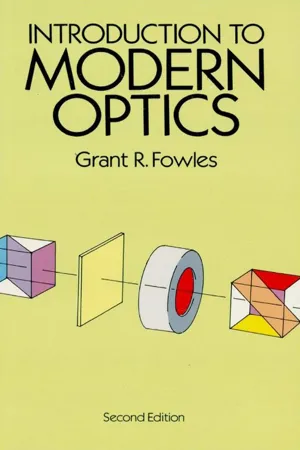
Introduction to Modern Optics
Grant R. Fowles
- 336 pages
- English
- ePUB (adapté aux mobiles)
- Disponible sur iOS et Android
Introduction to Modern Optics
Grant R. Fowles
À propos de ce livre
This incisive text provides a basic undergraduate-level course in modern optics for students in physics, technology and engineering. The first half of the book deals with classical physical optics; the second principally with the quantum nature of light. Chapters 1 and 2 treat the propagation of light waves, including the concepts of phase and group velocities, and the vectorial nature of light. Chapter 3 applies the concepts of partial coherence and coherence length to the study of interference, and Chapter 4 takes up multiple-beam interference and includes Fabry-Perot interferometry and multilayer-film theory. Diffraction and holography are the subjects of Chapter 5, and the propagation of light in material media (including crystal and nonlinear optics) are central to Chapter 6. Chapters 7 and 8 introduce the quantum theory of light and elementary optical spectra, and Chapter 9 explores the theory of light amplification and lasers. Chapter 10 briefly outlines ray optics in order to introduce students to the matrix method for treating optical systems and to apply the ray matrix to the study of laser resonators.
Many applications of the laser to the study of optics are integrated throughout the text. The author assumes students have had an intermediate course in electricity and magnetism and some advanced mathematics beyond calculus. For classroom use, a list of problems is included at the end of each chapter, with selected answers at the end of the book.
Foire aux questions
Informations
CHAPTER 1
The Propagation of Light
1.1 Elementary Optical Phenomena and the Nature of Light
1.2 Electrical Constants and the Speed of Light




Table des matières
- Title Page
- Copyright Page
- Preface
- Table of Contents
- CHAPTER 1 - The Propagation of Light
- CHAPTER 2 - The Vectorial Nature of Light
- CHAPTER 3 - Coherence and Interference
- CHAPTER 4 - Multiple-Beam Interference
- CHAPTER 5 - Diffraction
- CHAPTER 6 - Optics of Solids
- CHAPTER 7 - Thermal Radiation and Light Quanta
- CHAPTER 8 - Optical Spectra
- CHAPTER 9 - Amplification of Light. Lasers
- CHAPTER 10 - Ray Optics
- APPENDIX I - Relativistic Optics
- REFERENCES
- ANSWERS TO SELECTED ODD-NUMBERED PROBLEMS
- Index
- A CATALOG OF SELECTED DOVER BOOKS IN SCIENCE AND MATHEMATICS
- DOVER BOOKS ON PHYSICS